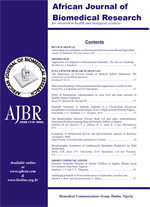
|
African Journal of Biomedical Research
Ibadan Biomedical Communications Group
ISSN: 1119-5096
Vol. 11, No. 1, 2008, pp. 33-37
|
 Bioline Code: md08005
Bioline Code: md08005
Full paper language: English
Document type: Research Article
Document available free of charge
|
|
|
African Journal of Biomedical Research, Vol. 11, No. 1, 2008, pp. 33-37
| en |
Prevalence of Antibodies to HAART Agents among HIV Patients in Benin city, Nigeria
Omoregie, R; Egbeobauwaye, A; Ogefere, H; Omokaro, E.U & Ekeh, C.C
Abstract
Against the background that some human immunodeficiency virus (HIV)-infected patients on the highly active antiretroviral therapy (HAART) still experience anaemia, some possible reasons for this were investigated. Blood was collected from 50 newly diagnosed treatment naive HIV-infected patients, 100 HIV-infected patients on HAART and 30 apparently healthy HIV seronegative individuals that served as controls. Haemotocrit values, red blood cell distribution width (RDW) and the presence of antibodies to the drugs in the HAART regimen were determined. The mean ± standard deviation of haematocrit values of HAART naive HIV patients (36.90 ± 5.61%) and those on HAART (37.20 ± 6.20%) were significantly lower compared to controls (41.50 ± 5.88%) (p = 0.001), though the difference between HIV patients on HAART and those that were HAART naive was not significant (p = 0.836). Although, the RDW of HIV patients were lower than controls, the difference was only significant (p = 0.026) between controls (17.00 ± 6.01%) and HAART naive HIV patients (15.00 ± 1.87). A total of 81 (81%) out of the 100 HIV patients on HAART had antibodies to one or more of the HAART drugs. Antibodies to nevirapine (58%) was higher compared to stavudine (44.6) and zidovudine (42%) ( p = < 0.05). There was no significant improvement in haematocrit of HIV patients on HAART over HAART naive HIV patients. Use of zidovudine, nutritional deficiency and presence of antibodies to the HAART drugs may have been responsible
Keywords
antiretroviral therapy, haematocrit, human immunodeficiency virus
|
| |
© Copyright 2008 - Ibadan Biomedical Communications Group
|
|
